Article and all photos by Joe Mock, BaseballParks.com
All rights reserved
If you haven’t attended a game at Petco Park, the new home of the Padres, then you’ve probably seen it on TV. And if so, then you haven’t really seen it. Perhaps more than any other park, Petco has to be be visited to believed. Only then will you understand how truly different — wonderfully different — it is, and why it was the winner of BASEBALLPARKS.COM’s fifth annual New Ballpark of the Year award! (You can read the press release making this announcement here.)
 |
| Glistening in the San Diego night, Petco Park is a stunning addition to the Major League Baseball scene |
There are two main reasons the ballpark is so special. One is the “concept design” of the park itself, especially in ways that highlights on Sports Center won’t convey. The other is the park’s location, which is a stroke of genius.
But let’s look at Petco from top to bottom in BASEBALLPARKS.COM’s full review.
The Setting
| Ballpark Stats |
| First regular-season game: April 8, 2004 |
| Capacity: 42,500 fixed seats, 3,500 permitted for General Admission |
| Price: $294.1 million for construction only; $453.4 million counting land and infrastructure |
| Alternate nicknames floating around: The Litter Box; The Animal House |
Since San Diego and Philadelphia both opened new ballparks in 2004, it’s only natural that Petco Park and Citizens Bank Park will be compared with each other. Concerning the location of the parks, our West Coast entry wins hands down … and I’m not saying this just because San Diego is a more pleasant city to visit. It’s the locations within the cities that are incredibly different.
Instead of merely dropping the new ballpark in the parking lot of the old one (like in Philadelphia), the city of San Diego wanted to do something special, something that could invigorate another part of town. In this regard, the decision to build the new park in the East Village area of downtown was made with the hope that the outcome would be similar to Baltimore, Denver and Cleveland, and like is occurring more slowly in Houston and Phoenix. Out of fairness, it has not happened as hoped in Atlanta or Arlington, but this won’t be the case in San Diego.
Here’s why. The new stadium is part of a larger project, one that designates 26 blocks of East Village as a “Ballpark District.” The agreement with the team required that the Padres and their development partners commit to at least $311 million in new construction within the district. Indeed, construction abounds on the west and north sides of the ballpark — areas with rundown buildings and vacant lots before — and at last count, the investment in construction has approached $600 million.
This will make the park’s surroundings nicer as time goes along … but it is still very impressive today. One reason for this is that a wonderful area of downtown is adjacent to the new park. The Gaslamp Quarter, which has been designated as a National Historic District, is a 16-block area of shops and great restaurants that is on the west side of the ballpark.
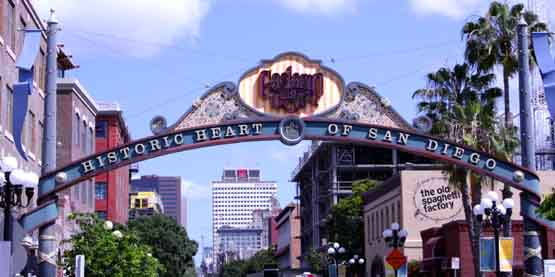 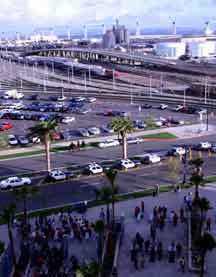 |
| Just to the west of the ballpark is the 16-block historic area known as the Gaslamp Quarter. On the right, fans are entering the ballpark from the southeast at the main gate. From the concourse of the park, you can look down upon this scene, as well as the San Diego Bay and massive Coronado Bridge. |
San Diego’s beautiful Convention Center is only a couple of blocks from the park, and it borders the lovely Bay, with all of its sail boats, cruise ships and Navy vessels.
Does this location mean that the ballpark offers fans a great view? Pretty much. From the seating bowl, you see some of the high-rises of downtown beyond left field, and (even better) the hill on which Balboa Park is located in the distance beyond right field. And as is the case in Seattle, there are wonderful views from the upper concourses, as you can look out at the San Diego Bay.
And it goes without saying that San Diego is a “destination city” in and of itself. The spectacular weather and the number of great attractions make this a locale worth visiting, no matter where you live. There’s the world-famous zoo, the coastline, stunning mountains — it’s got it all. The aforementioned Gaslamp Quarter and North Park San Diego are two sections of America’s Finest City that you should check out on your trip here.
So the city is quite nice, but you know what I like best about the exact spot where Petco Park is located? It treats the sport of baseball the way it’s supposed to be treated: special. San Diego didn’t simply toss the new facility in a spot off an Interstate exit in the middle of a sea of asphalt parking lots. No, Petco is a throwback to the way things used to be, when the sport was played in a neighborhood ballpark.
The Exterior
Does it really matter how the outside of a sports facility looks? After all, the fans buy tickets to sit inside.
Yes it matters, and San Diego knows that. A baseball stadium hosts events about 80 times during a season, but its exterior is seen 365 days a year. With this in mind, it is obvious that a huge amount of effort went into the aesthetics of the outside of Petco Park. When you look at the average stadium, you usually see just the stadium — the steel work, the backs of the seating sections, etc.
At Petco, though, you see much more. That’s because it possesses several outer buildings, two of which are called Garden Buildings, all of which are lovely. The building materials used are sandstone, imported from India, and stucco, with the colors being gold (which is meant to resemble the nearby cliffs of Torrey Pines) and a natural color that is complementary to the gold. The exposed steel has a “white marine finish that recalls San Diego’s nautical heritage,” according to the team’s media guide.
 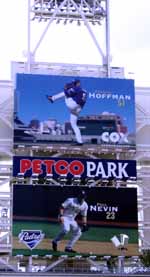 |
| The main entrance is on the southeast corner of the park, near the majority of parking and the trolley station. On the right is what you’ll see if you enter from the downtown side of Petco. |
If you’re coming to the ballpark from the north, you’ll see the beautiful seating bowl and the backside of the towering scoreboard (featuring huge photos of two Padres and the name of the park — see photo above). It’s almost as pretty a scene from the outfield side as behind home plate.
The Design
Did you know that 1909 was an incredibly relevant year for Petco Park? That’s because two interesting structures were constructed that year — 2,400 miles apart. In Pittsburgh, Forbes Field became the new home of the Pirates, and in San Diego, the Western Metal Supply Company building opened. What’s the connection?
| The most famous brick |
| Perhaps the most famous brick at any ballpark is embedded in the walkway of the Palm Court Plaza near the left-field entrance to the park. One of the 10,839 engraved bricks was surreptitiously purchased by PETA, sworn enemy of ballpark naming sponsor Petco. The brick says Break Open Your Cold Ones. Toast The Padres. Enjoy This Champion Organization. Now look at the first letter of each word (i.e., treat this as an acronym) and see what it spells. |
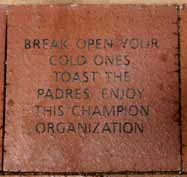 |
The connection is that both were very influential in creating Petco Park. First, Forbes Field was, according to the Padres, the last big-league stadium to have a public park beyond its outfield … and Petco was designed to include a “Park at the Park.” This 2.7-acre area lies beyond the outfield, and it includes a kid-size ball diamond and “Picnic Hill,” which is a raised area beyond right-center where families can sit on a blanket and watch the Padres play — a la spring-training ballparks and many in the Minors. Watching a game from here isn’t “roughing it” like at other venues, as Petco Park provides a large, color video screen on the back side of the “batter’s eye” backdrop showing a live feed of the game. Not only do you get to see replays, you also can observe plays made in parts of the field not visible from the hill.
The Western Metal Supply Company building is important because, well, it is still standing. Normally it would have been demolished to make way for the construction of the ballpark, but early on, the architects decided to leave it in place as an integral part of the stadium — in much the same way the B&O Warehouse is in Baltimore.
This rustic brick building is functional in countless ways. First, the largest souvenir shop at the park is housed on its first floor. The second and third floors have party suites, complete with four rows of seats built onto the field-facing front of the building. The fourth level has a huge eating area called the Hall of Fame Bar and Grill, with a limited number of tables on a patio that look out at the action on the field. It also features “lockers” of memorabilia of members of the Padres Hall of Fame, including Tony Gwynn, Dave Winfield and Randy Jones.
Even the rooftop of the building is utilized. Here, groups can hold private parties and just like on Waveland and Sheffield Avenues in Chicago, there are bleachers from which to watch the game on the field below.
So the Park at the Park and the 95-year-old brick building are the two most interesting elements of Petco’s design, but there is another that demands mention — well, two, really. They are the two towers that rise up through the stands behind first base and behind third. Aesthetically, I like them a lot because they break up the monotony of endless sections in the upper deck. Functionally, they each hold five luxury suites (the top three are high above the field), one contains a small souvenir shop, and on top of both are large banks of lights.
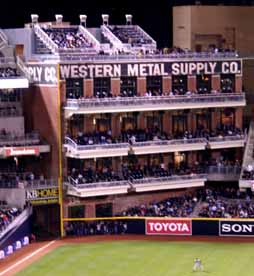 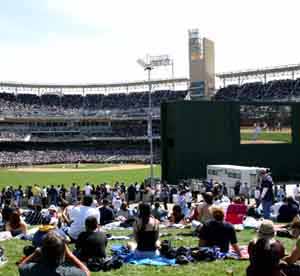 |
| Two brilliant elements of Petco Park’s design are the 95-year-old Western Metal Supply Company building and the Park at the Park. Note the large video screen (in the right-hand portion of the shot on the right) that permits those sitting on “Picnic Hill” to follow all aspects of the action. |
How did this novel design come about? Because some of the brightest architectural minds in the business teamed up to create, according to the Padres, the “world’s best ballpark in America’s Finest City.” First, Antoine Predock, known far and wide for designing some of America’s most stunning museums, libraries and arts centers, was the “design architect,” which means that the park reflects his concept — a concept carried out flawlessly by the biggest name in sports-facility architecture, HOK. Predock had never applied his skills to a ballpark before, and it shows — in a very, very good way. Never before had a baseball stadium been designed with outer buildings like this — and from the outside, and once you are inside roaming between the structures, I have to say that it is brilliant.
| Towering presence |
| I give the architects credit for doing things differently at Petco. Behind 1B and 3B are huge towers that not only support banks of lights, they also provide aesthetically pleasing breaks in the upper decks. |
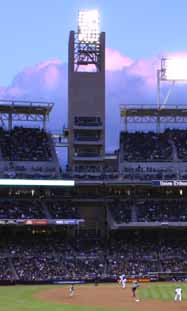 |
These outer “garden buildings” contain offices, stairways, concession stands, restrooms and areas for season-ticket holders.
The Home Plate Plaza on the street level at the main entry to the park certainly deserves mention. It not only pays tribute to the founding partners of the team and park (like Budweiser and Petco), it also features water flowing down the facing of a wall and beautiful landscaping.
The landscaping around the park is special in its own right. A local firm, Spurlock Poirier, was the landscape architect, and the vegetation they used, and the places they selected, can only be described as stunning. Brightly blooming coral trees and palms are strategically placed along the concourses, and flowering vegetation, that will only become more beautiful as it grows in, hangs from the edges of walkways and on trellises on the top of the “garden building” behind third base.
So this is a “scenic” park, but there are also countless vantage points from which to stand and watch the game (or from which to take pictures). In this regard, Petco is quite similar to Safeco Field in Seattle. In other words, two things you must do when attending a game in San Diego: bring your camera; and spend some time during the game roaming around the park and taking pictures from all of the great vantage points.
There are two quirky elements of Petco’s design. First, the outfield dimensions are anything but symmetrical! Get this: 334 feet down the left-field line; 358 to left; 402 in left center; 396 in dead center; 411 in right center; 322 down the right-field line. And the area near the foul pole in right is especially treacherous for right fielders, because the stands jut out into fair territory there. All in all, the dimensions are anything but uniform — much like Minute Maid Park in Houston. However, I’ve never been crazy about the quirkiness in Houston. I like the way it’s executed in San Diego, though.
The other quirky element is the placement of the bullpens. One is just beyond the fence in left field. The other is in foul territory along the seats down the first-base line. Again, not very symetrical. But here’s the oddest aspect of this: the home dugout is on the first-base side, but the home bullpen is the one way out in left field. This means that the visitors use the third-base dugout and the bullpen down the first-base line. Not only is this illogical to me, it also strikes me as a little unfair that the visiting team’s relievers have to warm up in an area that is in play, and inches away from the enemy spectators.